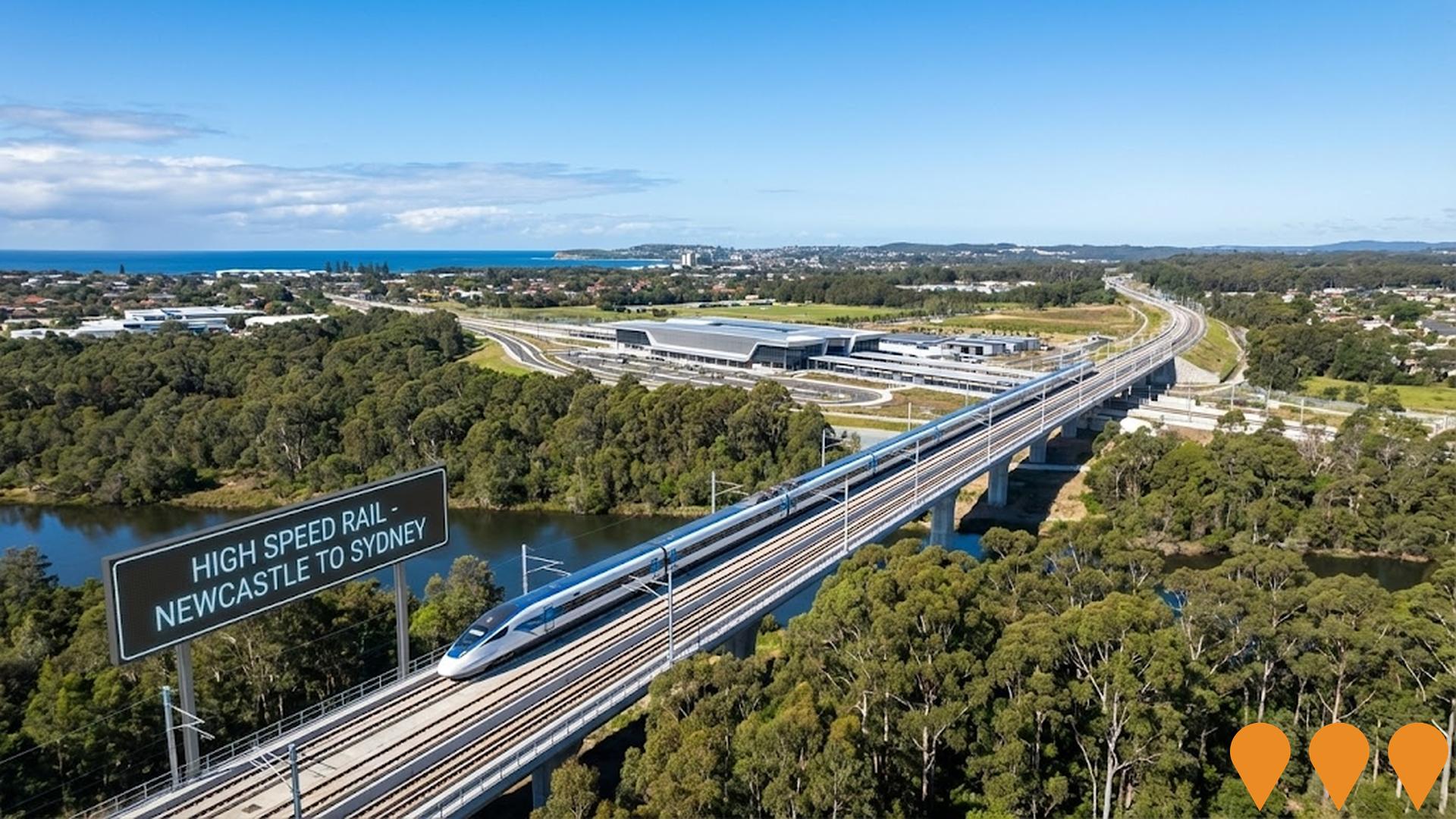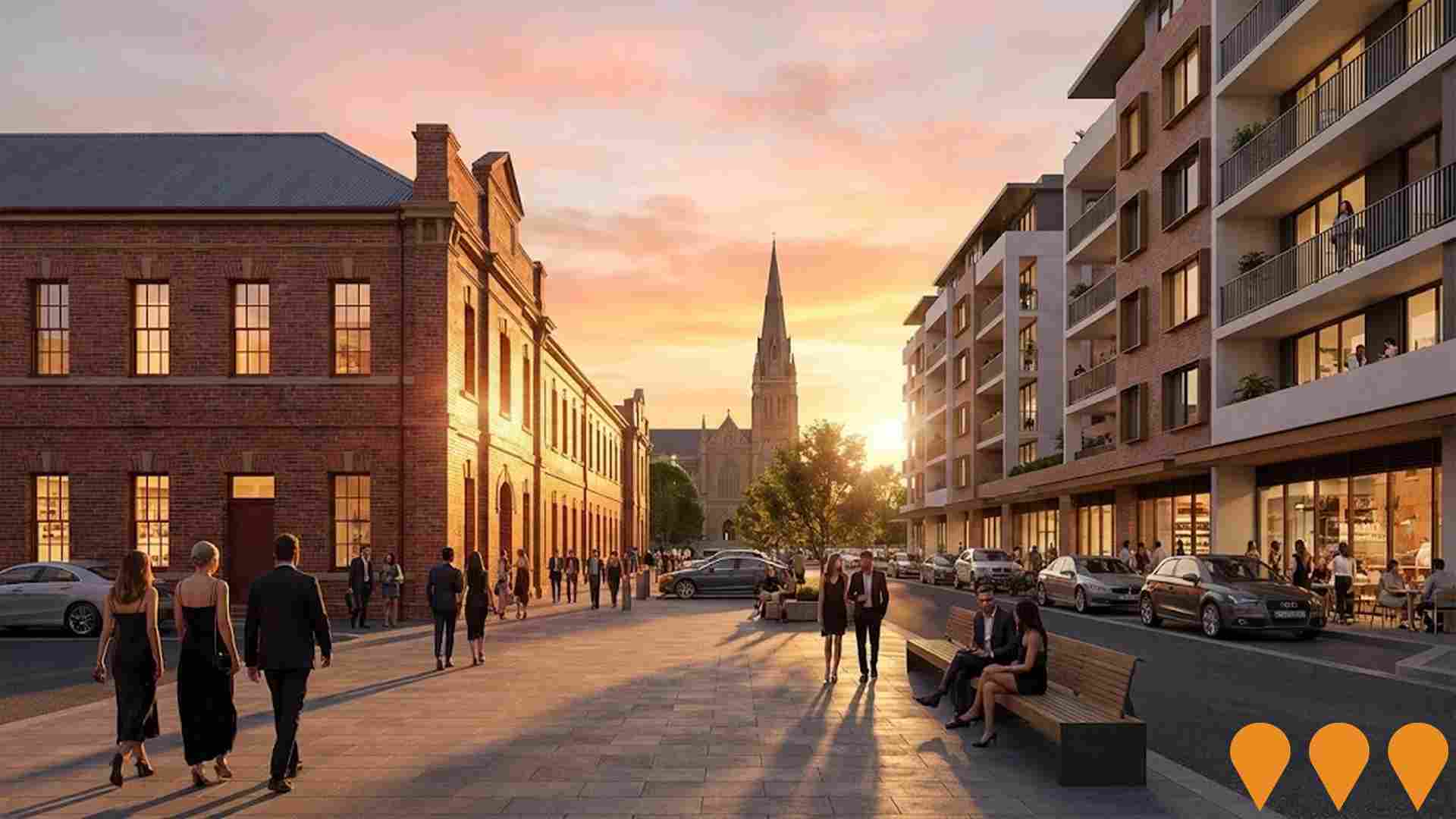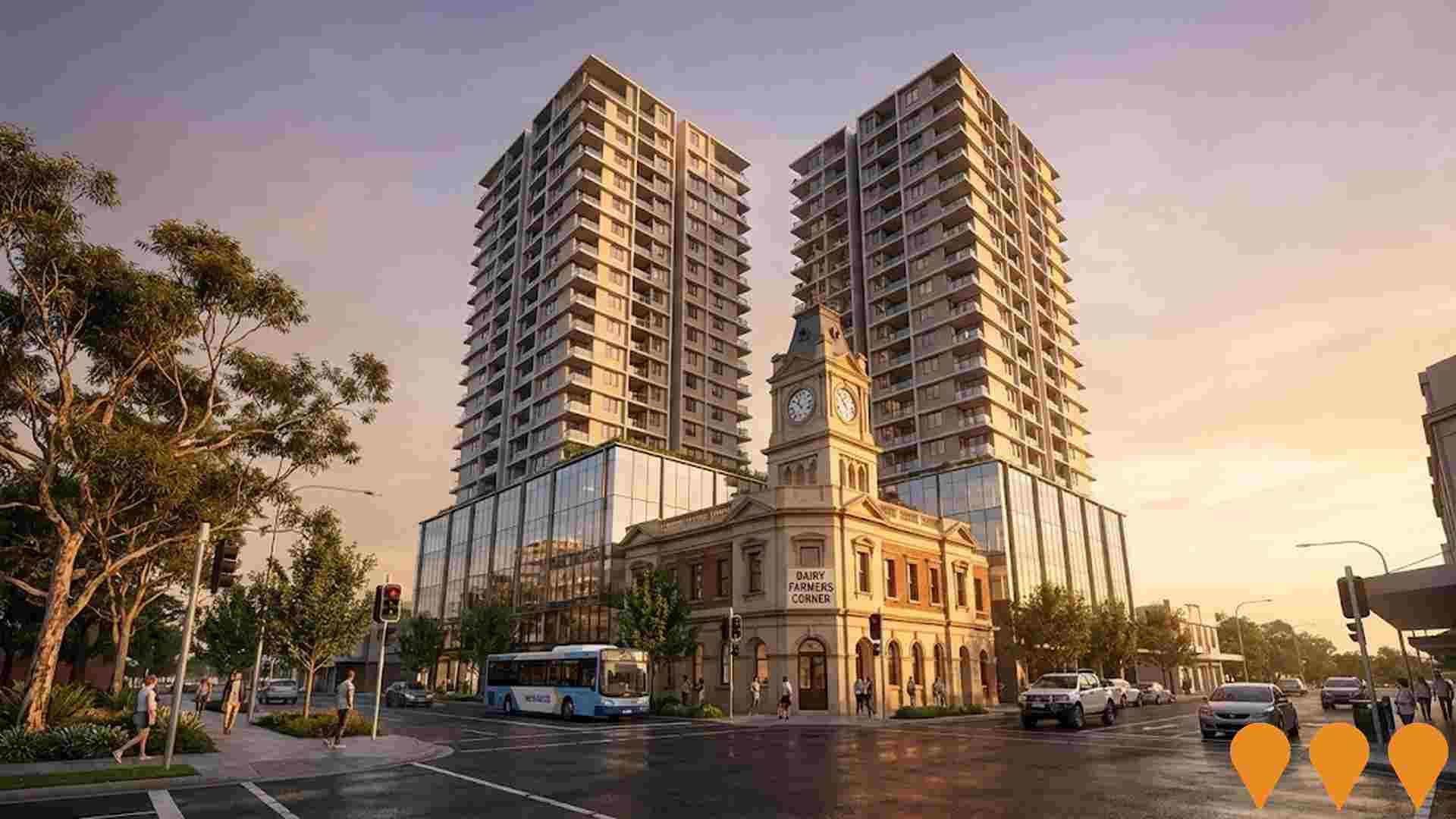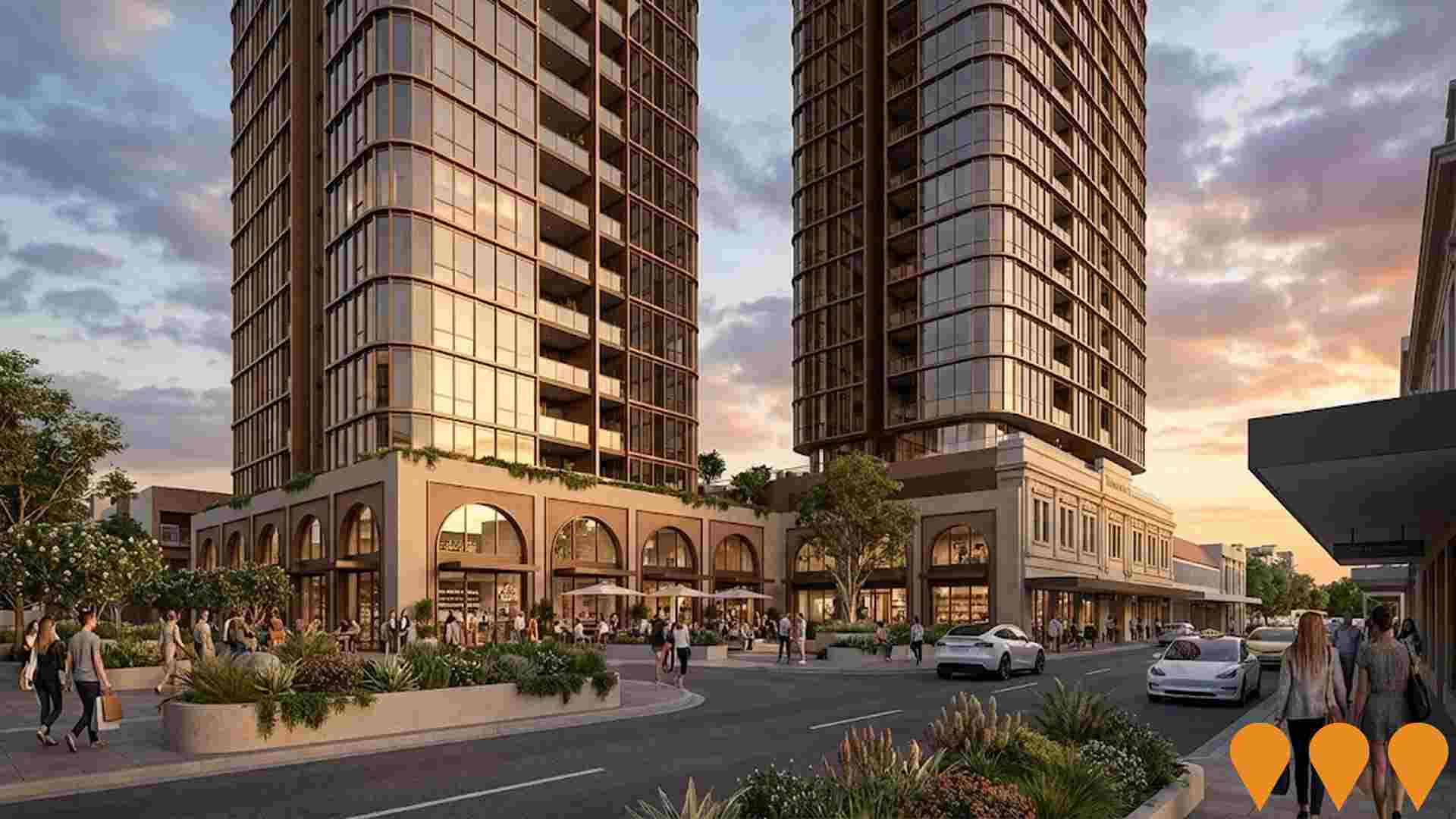Chart Color Schemes
est. as @ -- *
ABS ERP | -- people | --
2021 Census | -- people
Sales Activity
Curious about local property values? Filter the chart to assess the volume and appreciation (including resales) trends and regional comparisons, or scroll to the map below view this information at an individual property level.
Find a Recent Sale
Sales Detail
Population
Newcastle - Cooks Hill lies within the top quartile of areas nationally for population growth performance according to AreaSearch analysis of recent, and medium to long-term trends
Newcastle - Cooks Hill's population is approximately 14,560 as of Aug 2025. This figure represents an increase of 1,755 people since the 2021 Census, which reported a population of 12,805. The growth is inferred from ABS estimates: 14,264 in June 2024 and an additional 420 validated new addresses post-Census. This results in a density ratio of 3,658 persons per square kilometer, placing Newcastle - Cooks Hill in the upper quartile nationally. The area's growth rate of 13.7% since the 2021 Census exceeded both the non-metro average (4.8%) and the SA4 region, indicating it as a growth leader. Overseas migration contributed approximately 55.9% to recent population gains, with all drivers being positive factors.
AreaSearch uses ABS/Geoscience Australia projections for each SA2 area released in 2024 with a base year of 2022, and NSW State Government's SA2 level projections for areas not covered by this data, released in 2022 with a base year of 2021. Growth rates by age group are applied to all areas from these aggregations for years 2032 to 2041. Future projections anticipate exceptional growth, placing Newcastle - Cooks Hill in the top 10 percent of non-metropolitan areas nationally. By 2041, the area is expected to increase by 6,824 persons based on latest population numbers, marking a total increase of 44.8% over the 17-year period.
Frequently Asked Questions - Population
Development
The level of residential development activity in Newcastle - Cooks Hill was found to be higher than 90% of real estate markets across the country
Newcastle - Cooks Hill has received approximately 236 dwelling approvals annually. Between FY-21 and FY-25, a total of 1,180 homes were approved, with none yet in FY-26. On average, each new dwelling constructed over the past five financial years accommodated around 1.7 new residents per year. This figure has recently eased to 1 person per dwelling over the past two financial years.
The average construction value of new homes is $678,000. In FY-26, commercial approvals have reached $207.4 million. Compared to Rest of NSW, Newcastle - Cooks Hill shows 220.0% higher new home approvals per capita. Recent construction comprises approximately 2.0% standalone homes and 98.0% townhouses or apartments. Around 29 people are expected to reside in each dwelling approved. Population forecasts indicate an increase of 6,528 residents by 2041.
Current development levels appear consistent with future population growth needs, suggesting stable market conditions without significant price pressures.
Frequently Asked Questions - Development
Infrastructure
Newcastle - Cooks Hill has strong levels of nearby infrastructure activity, ranking in the top 30% nationally
Changes in local infrastructure significantly affect an area's performance. AreaSearch has identified 55 projects that may impact the area. Notable projects include East End Newcastle, Dairy Farmers Towers, The Store Newcastle, and Pottery Lane Residential Development - Newcastle. Below is a list detailing those likely to be most relevant.
Professional plan users can use the search below to filter and access additional projects.
INFRASTRUCTURE SEARCH
 Denotes AI-based impression for illustrative purposes only, not to be taken as definitive under any circumstances. Please follow links and conduct other investigations from the project's source for actual imagery. Developers and project owners wishing us to use original imagery please Contact Us and we will do so.
Denotes AI-based impression for illustrative purposes only, not to be taken as definitive under any circumstances. Please follow links and conduct other investigations from the project's source for actual imagery. Developers and project owners wishing us to use original imagery please Contact Us and we will do so.
Frequently Asked Questions - Infrastructure
High Speed Rail - Newcastle to Sydney (Stage 1)
The first stage of the proposed National High Speed Rail network aims to connect Newcastle to Sydney via the Central Coast, reducing travel time to approximately one hour with trains reaching speeds up to 320 km/h. The project is focused on the development phase, which includes design refinement, securing planning approvals, and corridor preservation. It is being advanced by the Australian Government's High Speed Rail Authority (HSRA). Stations are planned for Broadmeadow, Lake Macquarie, Central Coast, and Central Sydney. The long-term vision is a national network connecting Brisbane, Sydney, Canberra, and Melbourne.

East End Newcastle
Iris Capital's $1 billion urban renewal precinct transforming Newcastle's East End across four city blocks. The multi-stage project delivers over 800 luxury apartments, retail, dining, entertainment, commercial space and the QT Newcastle hotel. Heritage buildings including the former David Jones, Fabric House and Municipal Building have been preserved and adaptively reused. Stages 1-3 are complete or substantially complete, Stage 4 (Lyrique & Kingston buildings, 195 apartments) is under construction with completion expected 2027.

Dairy Farmers Towers
Newcastle's tallest residential towers comprising 191 luxury apartments across two towers (99m and 89m) at the historic Dairy Farmers Corner. Features 1, 2 & 3 bedroom apartments with 5 floors of commercial space, pool with harbour views, gym, wine bar, shared work hub, and 360-degree Newcastle vistas. Plans include reimagining heritage structures for a public art installation.

The Store Newcastle
A major redevelopment of the historic former Newcastle Co-Operative Store site into two luxury residential towers (28 and 30 storeys) comprising 352 apartments (1-4 bedrooms), ground-floor retail and commercial spaces, and one acre of resort-style amenities including swimming pool, tennis court, rooftop observation deck, private event spaces, and landscaped areas. Developed by Doma Group, the project sets a new benchmark for apartment living in Newcastle with premium finishes and unparalleled city, harbour, and beach views.

Harbour Foreshore Precinct - Foreshore Park Inclusive Playspace
City of Newcastle is delivering the centrepiece of the Harbour Foreshore Masterplan: an inclusive regional playspace and waterplay area known as Livvi's Place at the western end of Foreshore Park. The project includes bespoke play equipment (e.g., whale-themed swing set), nature and water play, accessible paths, amenities and kiosk, and significant landscaping to enhance shade and accessibility. Partners include Touched by Olivia and Variety NSW/ACT. Design and construction contract awarded to Regal Innovations in March 2025; works commenced July 2025 with completion targeted for late 2026.

Newcastle Art Gallery Expansion
Major expansion of Newcastle Art Gallery to create a contemporary arts and cultural hub, including new contemporary galleries, education facilities, conservation laboratories, public amenities, exhibition spaces, and community areas. Part of Newcastle's cultural precinct development strategy with enhanced accessibility and visitor experience to enhance cultural offerings in the city.

Pottery Lane Residential Development - Newcastle
525 high-quality residential units development by Olympian Homes in the Forth Goods Yard area of Newcastle city centre. Build-to-rent scheme funded by Hines, featuring net-zero enabled design with geothermal heat pumps and solar PV. Two phases with completion by 2027.

Newcastle Grammar School Park Campus Redevelopment
The redevelopment of the Park Campus, which is the Junior School for K-6, involved constructing a contemporary three-storey building with new classrooms, flexible learning and collaborative spaces, an undercover play area, and a rooftop multi-sport court. The project allows Years 5 and 6 to relocate to the Park Campus. Stage 1 construction commenced in September 2023 and the new learning spaces officially opened to students in May 2025. The project has an estimated value of $30 million.

Employment
Employment performance in Newcastle - Cooks Hill exceeds national averages across key labour market indicators
Newcastle - Cooks Hill has a highly educated workforce with strong representation in professional services. The unemployment rate is 3.1%.
Over the past year, employment grew by an estimated 2.0%. As of June 2025, 9,271 residents are employed, with an unemployment rate of 0.6% below Rest of NSW's rate of 3.7%, and workforce participation at 68.5% compared to Rest of NSW's 56.4%. Key industries include health care & social assistance, professional & technical, and education & training. The area specializes in professional & technical jobs, with an employment share 2.4 times the regional level.
Agriculture, forestry & fishing employs just 0.5% of local workers, below Rest of NSW's 5.3%. There are 1.7 workers for every resident, indicating it functions as an employment hub attracting workers from surrounding areas. Between June 2024 and June 2025, employment increased by 2.0%, labour force grew by 2.5%, resulting in a rise in unemployment of 0.5 percentage points. In comparison, Rest of NSW recorded an employment decline of 0.1%, labour force growth of 0.3%, with unemployment rising by 0.4 percentage points. Jobs and Skills Australia's national employment forecasts from May 2025 project national employment growth of 6.6% over five years and 13.7% over ten years. Applying these projections to Newcastle - Cooks Hill's employment mix suggests local growth of approximately 7.5% over five years and 15.2% over ten years, though these are simple extrapolations for illustrative purposes only.
Frequently Asked Questions - Employment
Income
The area exhibits notably strong income performance, ranking higher than 70% of areas assessed nationally through AreaSearch analysis
AreaSearch's latest postcode level ATO data for financial year 2022 indicates that income in Newcastle - Cooks Hill is among the highest in Australia, with a median income of $59,678 and an average income of $92,896. This contrasts with Rest of NSW's figures of a median income of $49,459 and an average income of $62,998. Based on Wage Price Index growth of 12.61% since financial year 2022, current estimates would be approximately $67,203 (median) and $104,610 (average) as of September 2025. Census 2021 income data shows individual earnings stand at the 88th percentile nationally ($1,149 weekly), though household income ranks lower at the 61st percentile. Distribution data indicates that the $1,500 - 2,999 bracket dominates with 32.4% of residents (4,717 people), aligning with the surrounding region where this cohort likewise represents 29.9%. High housing costs consume 17.6% of income, however strong earnings still place disposable income at the 59th percentile and the area's SEIFA income ranking places it in the 8th decile.
Frequently Asked Questions - Income
Housing
Newcastle - Cooks Hill features a more urban dwelling mix with significant apartment living, with a higher proportion of rental properties than the broader region
In Newcastle - Cooks Hill, as per the latest Census evaluation, 11.7% of dwellings were houses while 88.3% comprised semi-detached homes, apartments and other types. This contrasts with Non-Metro NSW's figures of 70.5% houses and 29.5% other dwellings. Home ownership in Newcastle - Cooks Hill stood at 26.1%, with mortgaged dwellings at 19.7% and rented ones at 54.2%. The median monthly mortgage repayment was $2,169, exceeding Non-Metro NSW's average of $1,962. Meanwhile, the median weekly rent was $445, compared to Non-Metro NSW's $400. Nationally, Newcastle - Cooks Hill's median monthly mortgage repayment is higher at $2,169 than Australia's average of $1,863, while its median weekly rent figure stands at $445, above the national average of $375.
Frequently Asked Questions - Housing
Household Composition
Newcastle - Cooks Hill features high concentrations of lone person households and group households, with a lower-than-average median household size
Family households account for 49.2% of all households, including 12.9% couples with children, 29.1% couples without children, and 6.2% single parent families. Non-family households constitute the remaining 50.8%, with lone person households at 40.8% and group households comprising 10.1%. The median household size is 1.9 people, which is smaller than the Rest of NSW average of 2.4.
Frequently Asked Questions - Households
Local Schools & Education
The educational profile of Newcastle - Cooks Hill exceeds national averages, with above-average qualification levels and academic performance metrics
Educational attainment in Newcastle - Cooks Hill is notably high, with 48.0% of residents aged 15 years and above holding university qualifications. This compares favourably to the broader benchmarks of 21.3% in Rest of NSW and 26.1% in the SA4 region. The area's educational advantage is reflected in its strong showing for knowledge-based opportunities. Bachelor degrees are most prevalent at 30.7%, followed by postgraduate qualifications (13.3%) and graduate diplomas (4.0%).
Vocational credentials are also prominent, with 27.1% of residents aged 15 years and above holding such qualifications - advanced diplomas account for 10.4% while certificates make up 16.7%. Educational participation is high, with 27.5% of residents currently enrolled in formal education. This includes 12.8% in tertiary education, 4.9% in primary education, and 4.5% pursuing secondary education. There are eight schools operating within Newcastle - Cooks Hill, educating approximately 3085 students. The area shows above-average socio-educational conditions with an ICSEA score of 1070. The educational mix includes two primary schools, five secondary schools, and one K-12 school. School capacity exceeds typical residential needs at 21.2 places per 100 residents compared to the regional average of 15.6, indicating that Newcastle - Cooks Hill serves as an educational hub for the broader region. Note: where schools show 'n/a' for enrolments, please refer to the parent campus.
Frequently Asked Questions - Education
Schools Detail
Nearby Services & Amenities
Transport
Transport servicing is high compared to other areas nationally based on assessment of service frequency, route connectivity and accessibility
Newcastle-Cooks Hill has 82 active public transport stops. These include ferry, lightrail, and bus services. There are 42 individual routes operating in total, providing 9,015 weekly passenger trips.
Residents have excellent accessibility to transport, with an average distance of 116 meters to the nearest stop. The service frequency is 1,287 trips per day across all routes, which equates to approximately 109 weekly trips per individual stop.
Frequently Asked Questions - Transport
Transport Stops Detail
Health
Newcastle - Cooks Hill's residents are healthier than average in comparison to broader Australia with prevalence of common health conditions quite low across both younger and older age cohorts
Newcastle - Cooks Hill residents show low prevalence of common health conditions across younger and older age groups. Private health cover stands at approximately 68% (9,929 people), higher than Rest of NSW's 55.6%. Nationally, it averages 55.3%.
Mental health issues affect 10.7%, asthma impacts 7.9%, while 68.1% report no medical ailments, compared to Rest of NSW's 64.9%. The area has 18.3% (2,671 people) aged 65 and over, higher than Rest of NSW's 16.7%. Seniors' health outcomes are strong, outperforming the general population in health metrics.
Frequently Asked Questions - Health
Cultural Diversity
Newcastle - Cooks Hill ranks below the Australian average when compared to other local markets across a number of language and cultural background related metrics
Newcastle-Cooks Hill had lower cultural diversity, with 87.4% citizens, 82.0% born in Australia, and 89.7% speaking English only at home. Christianity was the predominant religion at 39.2%. Judaism was overrepresented at 0.2%, compared to 0.1% regionally.
The top three ancestry groups were English (30.9%), Australian (22.6%), and Irish (11.2%). Scottish (9.9%) and Polish (0.9%) groups were also notably represented, differing from regional averages of 8.4% and 0.8%, respectively. Welsh representation was similar to regional levels at 0.8%.
Frequently Asked Questions - Diversity
Age
Newcastle - Cooks Hill's population is slightly younger than the national pattern
The median age in Newcastle - Cooks Hill is 38, which is lower than the Rest of NSW figure of 43 but equivalent to the national norm of 38. The age group of 25-34 shows strong representation at 22.9%, compared to Rest of NSW's figure, while the 5-14 cohort is less prevalent at 5.0%. This 25-34 concentration is notably higher than the national average of 14.5%. According to the 2021 Census, the 25 to 34 age group has increased from 21.5% to 22.9%, while the 5 to 14 cohort has decreased from 6.2% to 5.0%, and the 45 to 54 group has dropped from 12.3% to 11.2%. Demographic projections suggest that Newcastle - Cooks Hill's age profile will significantly change by 2041, with the 25 to 34 age group expected to grow by 60%, reaching 5,333 people from the current 3,334.

